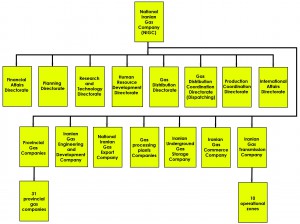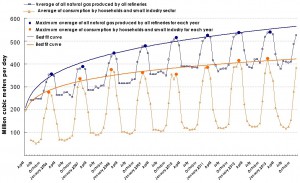August 2015, Vol. 242, No. 8
Features
Forecasting Irans Natural Gas Production, Consumption

Iran is a major energy-producing and exporting country with natural gas accounting for about 68% of its domestic energy consumption. Iran ranks second worldwide in terms of natural gas reserves. This is indicative of the importance of Iran’s gas in present as well as future national and international marketing.
This article focuses on the characteristics of production and consumption of natural gas in Iran for the previous 44 years and forecasts short- and long-term values up to 2035. This also provides a new model for predicting the future of the natural gas in these turbulent situations.
Iran has an area of about 1.648 million square km and a population exceeding 70 million. With its young population, high and growing energy demand per person, increasing urbanization and economic development, Iran has been one of the world’s growing power markets.
Because of its large gas reserves and the advantage of gas vs. oil, Iran’s energy policy is based on increasing gas and decreasing oil usages in both commercial and residential sectors. In Iran, the primary energy forms include fossil fuels such as natural gas, fuel oil, and gasoline.
Natural gas has a significant impact on the national economy. Iran’s estimated proved natural gas reserves are estimated at 33,600 Bcm, second only to Russia. Eighty percent of Iranian natural gas reserves are located in non-associated fields. Major natural gas fields include: South Pars, North Pars, Kish and Kangan.
Iran’s natural gas reserves are located primarily offshore, although significant associated gas production originates from the country’s onshore oil fields. The giant South Pars field, only a portion of which is in Iranian territory, comprises over 27% of Iran’s total proved natural gas reserves and is its largest gas field. With an estimated 12.74 Tcm of gas, the South Pars Gas Field contains about 6.8% of the world’s gas reserves (Golara 2014).
The country’s gas-treating and dehydration capacity from 1996-2014 indicates a substantial increase of 480 MMcm/d. The gas-treating and dehydration capacity during this period increased from 128 to 608 MMcm/d in 2014.
Since its establishment, the National Iranian Gas Company (NIGC) has improved its capabilities and access to a wide variety of experts and facilities that are equipped with scientific and theoretical vision along with much knowledge concerning tools, equipment and machinery.
As a result, NIGC has been implementing its operations proportionate with the national trend toward economic and social development. NIGC has also benefited from the prolific gas resource, one of the major fuels used for energy production and which provides a significant part of the required currency of the country. Currently, NIGC is carrying out its tasks in compliance with valid international standards on its own.
Modeling and predicting natural gas production and consumption play a vital role for policymakers and related organizations. At the start of 2014, NIGC with 539 MMcm/d refining capacity, had 33,000 km of high-pressure pipelines, 65 compressor stations and a gas-supplying network of over 150,000 km under its coverage that provided natural gas to over 12 million homes.
Accurate and reliable predictions of natural gas production and consumption are essential to any national energy policy. This article uses a logistic-based approach, focusing on the exact data since 1970, in attempting to forecast the future growth in natural gas consumption and production in Iran.
Demand, Production Forecast
Table 1 and Figure 2 show Iran’s total annual production of natural gas since 1970. During the initial stages, natural gas production tended to increase exponentially with time. During the corresponding growth phase, this rapid rate of growth is shown by the best fit production curves.
The curve starts slowly and then rises more steeply until finally an inflection point is reached after which it becomes concave downward. In order to fit a best logistic growth curve and predict the future of natural gas production, the best possible calculation of ultimate reserves is essential.
The ultimate reserves can’t be calculated definitively, but estimated. Applying this technique to the production of natural gas in Iran, Figure 2 shows a best fit graph of the production up to the present, for ultimate gas production of 600 Bcm/y.
The new model for predicting the future of natural gas production is acceptable for the long term and for a general overview of production. Because of economic constraints, from time to time, natural gas production follows other models. Total gas production data from 2006-13 indicates when the strongest constraints have been imposed on Iran’s oil and gas sector.
A better representation of the rate of growth of gas production can be obtained by plotting the logarithm of the total production vs. time from 2006-13 on a semi-logarithmic graph. As noted in this case and in short-term, the curve approximates a straight line until present.
Forecasting, especially in the energy sector, will always remain much more of an art than a science so some variations are to be expected, depending on the model’s underlying assumption. The main assumption is that the already existing trends in natural gas consumption will generally repeat.
A summary of recent data from 2005-13 (Figure 3) shows the monthly time series data on natural gas production and consumption by all refineries, households and small industry sectors per day. A closer look finds trends in the variable of time. A power trend line has been drawn through the data for clarity. As shown in this figure, these best fit curves yielded a reasonable estimate of the peak production of gas and consumption by households and small industry for each year.
Another result (Figure 3) is that the locations of production peaks are so closely related to growth of consumption by households and small industry in Iran. It may seem surprising that most of the gas in winter is consumed by households and small industries. Although the climate is moderate, temperatures are notably cooler in the winter months, and natural gas is the fuel of choice for residential heating in Iran. That the annual average gas consumption by households and small industry is 50% of the total annual production verifies this.
The average consumption of compressed natural gas in Iran is 19 Bcm/d. However, the largest amount of gas used is that which is transported in pipelines to consumers. And despite well-defined plans for liquefied natural gas (Figure 4), due to economic constraints, the production and consumption of LNG is zero today.
Iran is planning to develop its natural gas pipeline network by extending it to its eastern and western borders to become a major hub for natural gas transactions. Expansion of cross border-piped gas trade volume to a net of about 40 Bcm/y over the next five years is one of Iran’s main strategic goals. In pursuance of the policy to become a major exporter of natural gas, Iran plans to construct five LNG plants with a total capacity of nearly 67.5 MT per year. These projects are now in various phases of design or engineering, procurement and construction tendering.
The estimation and forecasting procedure outlined previously provide the results. The procedure is based on generic algorithm (GA). In this approach, the objective is to minimize a given cost function, subject to certain constraints. GA continues searching for this optimal solution until a specified termination criterion is met.
Study Conclusions
Short- and long-term forecasting of natural gas production, based on realistic data, is a prerequisite to becoming an industrialized country and providing a healthy gas market. Energy planning is not possible without a reasonable knowledge of past and present natural gas consumption. Overestimating the natural gas demand may cause redundancy in resources, while underestimating may lead to energy crises.
The main objectives of this article have been to estimate short- and long-term natural gas production and find a reasonable estimate of peak gas consumption by households and small industry. In summary:
1. Most of the gas in winter is consumed by households and small industries in Iran.
2. The maximum consumption in Iran occurs in January or early February.
3. The locations of production peaks are very closely related to growth of consumption by households and small industry in Iran.
4. A closer look at the monthly time series reveals a power trend line in the maximum gas consumption.
5. In the long term, Iranian natural gas production follows a logistic growth curve.
6. From time to time, because of economic constraints, natural gas production obeys a liner trend.
7. The growth rate of Iranian natural gas production has decreased to 8% because of the strongest economic constraints imposed on the oil and gas sector.
8. The total elimination of economic constraints would result in an increase of Iranian natural gas production growth rate to 10%.
9. Annual production of natural gas with big investments in new giant gas fields can reach an extremely high value of 450 Bcm/y in 2022.
Year Total production of natural gas (BCM/year)
1970 12.9
1975 20.3
1980 7.1
1985 14.6
1990 23.2
1995 35.3
2000 60.2
2005 103.5
2010 146.2
2013 163.0
Table 1: Iran total production of natural gas pre year since 1970-2013. Source EIA
Editor’s note: Reuters reported on June 26 that Gazprom may take part in LNG projects in Iran once sanctions against Tehran are lifted, Gazprom’s deputy CEO Alexander Medvedev said. “Gazprom does not rule out its participation in these projects under certain conditions. The sanctions should be lifted first.”
Russia has stepped up efforts to strengthen its with Iran and announced an oil-for-goods program in which the Islamic Republic would export up to 500,000 bpd to Russia in exchange for goods, including grain. An abundance of condensate and natural gas liquids in Iran make Iranian LNG export projects potentially highly competitive, even as supply swells due to U.S. shale gas and big finds off East Africa. Experts say, however, it would take a decade or more for Iran to became a major LNG export.
Authors: Ali Golara is senior officer with Strategic Planning Studies, National Iranian Gas Company (NIGC).
Hamid Bonyad is head of Research and Technology Development Research, and the Technology Directorate at NIGC.
Hedayat Omidvar is head of Communication Affairs with the Universities and Research Centers at NIGC.

Figure 1: A glance at NIGC administration and organization chart.

Figure 2: Iran’s total annual production of natural gas since 1970.

Figure 3: Total gas production from 2006-13 when the strongest economic constraints have been imposed on Iran’s oil and gas sector.

Figure 4

Figure 5: Natural gas production to present and four predictions for future scenarios.





Comments